LisbonLisboaPortugal.com
The best independent guide to Lisbon
LisbonLisboaPortugal.com
The best independent guide to Lisbon
Parque das Nações, Lisbon; a tourist guide for 2025
In a city celebrated for its historic charm, Parque das Nações presents a bold vision of the future. This striking waterfront district, defined by sweeping promenades and daring contemporary architecture, was born from one of the most ambitious urban renewal projects in Europe. What was once a desolate industrial wasteland was completely transformed to host the 1998 World’s Fair, an event that reimagined Lisbon’s relationship with the Tejo estuary.
Today, that legacy has evolved into a vibrant, family-friendly neighbourhood. This is a district of wide-open spaces, tranquil water gardens, and a skyline shaped by glass and steel, all stretching along the serene banks of the Tejo estuary. Here, you can explore the world-class Oceanário de Lisboa, enjoy the hands-on exhibits of the Pavilhão do Conhecimento science museum, or glide high above it all on the cable car.
While visitors flock to its attractions, Parque das Nações is also a thriving local community with a sophisticated, cosmopolitan energy. Its excellent restaurants, trendy bars, and major concert venue make it a centre for modern Lisbon life. This is not just a collection of attractions; it is Lisbon looking confidently forward, a vibrant symbol of the city's modern identity.
Highlights of the Parque das Nações
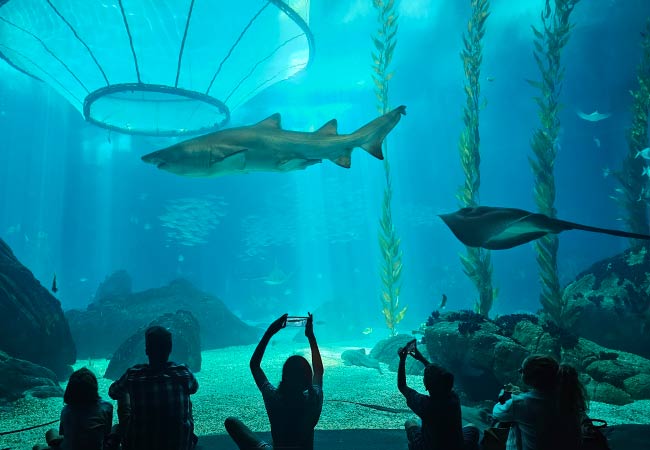
Oceanário de Lisboa – Europe's finest aquarium, with five giant tanks representing the world's different oceans. Children and adults alike will be enthralled by its vast diversity of marine life, and its ingenious layout that allows the tanks to be seen from both above and below the waterline.

The Iberian lynx statue (Lince Ibérico) – A colossal, eye-catching piece of urban art constructed from waste, created to highlight overconsumption by humans and the endangered species it impacts. In 2002, it was estimated that there were fewer than 100 Iberian lynx left in the wild.
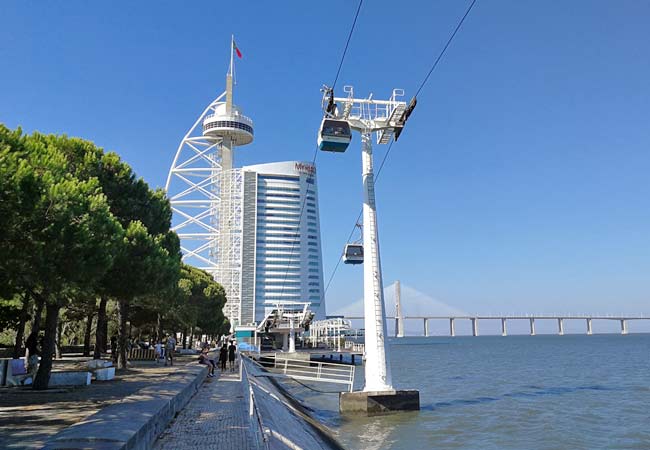
The Telecabine de Lisboa – Glide high above the park in a cable car, offering views of the Tejo Estuary, the Vasco da Gama Bridge and the Torre Vasco da Gama, the tallest building in Portugal.
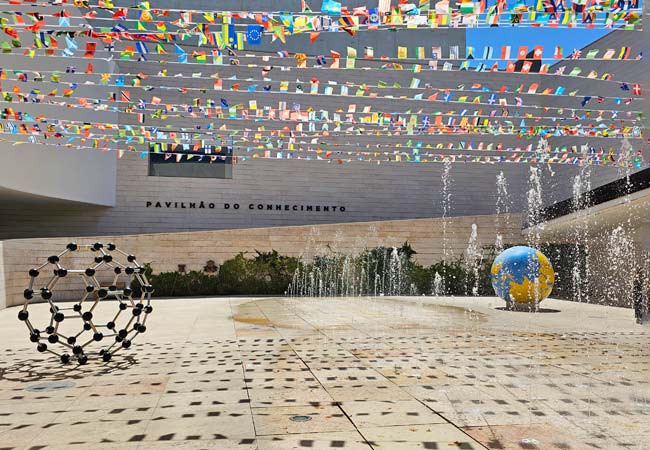
Pavilhão do Conhecimento - Outstanding interactive science museum, ideal for children and one of the best family-based activities in Lisbon.
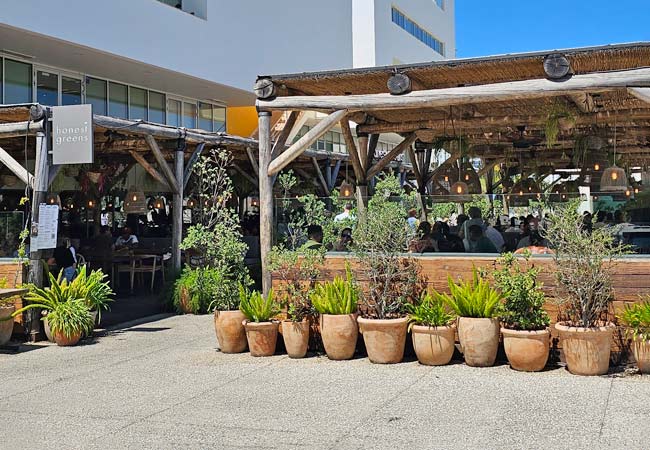
Dining Out – Parque das Nações is one of the best locations in Lisbon for dining out, offering a mix of high and medium-priced options that are designed for locals and tourists alike. Outstanding restaurants include D'Bacalhau (Portuguese), Honest Greens (vegetarian), The Old House (Chinese), and 100 Montaditos for inexpensive drinks and Mexican cuisine.
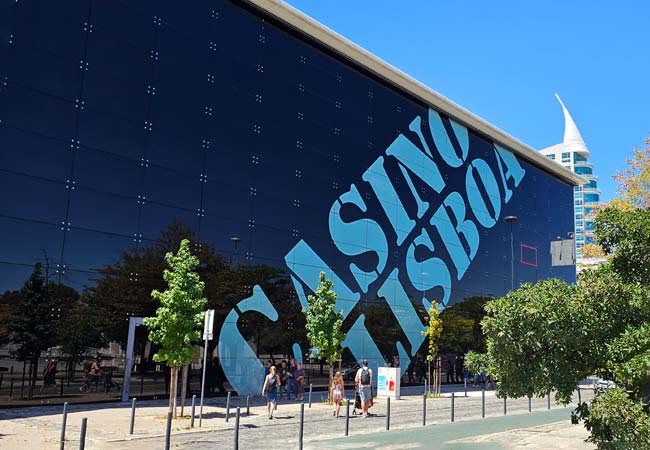
Casino de Lisboa – Lisbon's sleek and modern casino spans four floors of gaming excitement.
A suggested tour of the Parque das Nações
The Parque das Nações takes around half a day to visit, but this could be easily extended by visiting the Oceanário de Lisboa or the Pavilhão do Conhecimento.
One of the most enjoyable activities is taking a leisurely stroll along the waterfront, viewing all of the water gardens and exhibits before returning via the cable car.
The metro is the best way to travel to the Parque das Nações, and the area is served by the Oriente metro station on the red line. The metro is connected to the Vasco da Gama shopping centre, which is where most visitors start their trip.
Below is an interactive map for a suggested tour of the Parque das Nações, which begins at the Oriente metro station.
Main sights along the guided tour: 1) Estação do Oriente 2) Centro Vasco da Gama 3) Iberian lynx statue 4) Casino de Lisboa 5) Pavilhão do Conhecimento 6) Oceanário de Lisboa 7) Cable car south terminal 8) Jardins da Água 9) Garden Garcia de Orta 10) Torre Vasco da Gama
Entrance fees and costs
• Single metro ticket to Oriente Station – €1.85
• Entry to Parque das Nações – Free
• Lisbon Oceanarium – €24 (adult), €15.50 (child – 3 to 12)
• Cable car – Return €9.50 (adult), €6.50 (child – 3 to 12)
• Pavilhão do Conhecimento – €14 (adult), €8 (child), €9 (youth – 12 to 17)
Money-Saving Tip: The food court in the Centro Vasco da Gama shopping centre boasts a variety of excellent yet affordable dining options.
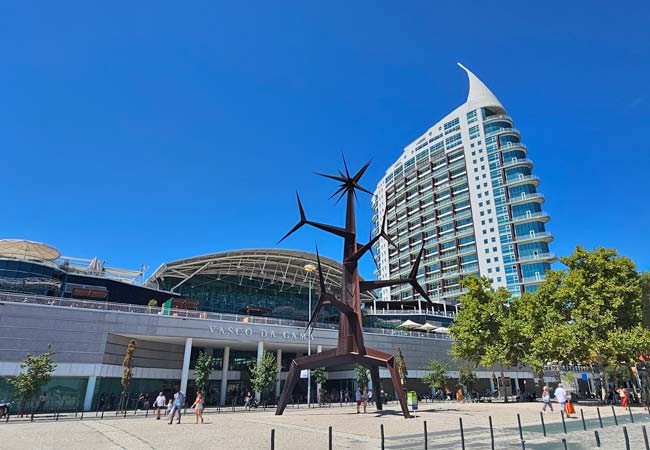
There are many interesting modern art exhibits within the district.
How about a small group tour?
One of the best ways to discover Lisbon and meet fellow travellers is to join a guided tour. We have worked with Getyourguide.com for the last six years, and some of their best tours of Lisbon include:
Parque das Nações for families
The Parque das Nações is one of the best areas in Lisbon for children and families. Children will adore the oceanarium, while the Pavilhão do Conhecimento is an engaging science museum with lots of hands-on activities.
The park also contains many free, water-focused exhibits (such as the Jardins da Água, water volcanoes and the waterfall), along with interactive play areas (such as the Jardim da Música). The entire area is traffic-free, peaceful and calm, and it is ideal for families to play or run about in – unlike much of compact and bustling central Lisbon.
Inside the Centro Vasco da Gama shopping centre, there is a large cinema complex and many good-value restaurants and fast-food eateries.
Our opinion: If you are travelling with children, we highly recommend planning to spend a day at Parque das Nações.
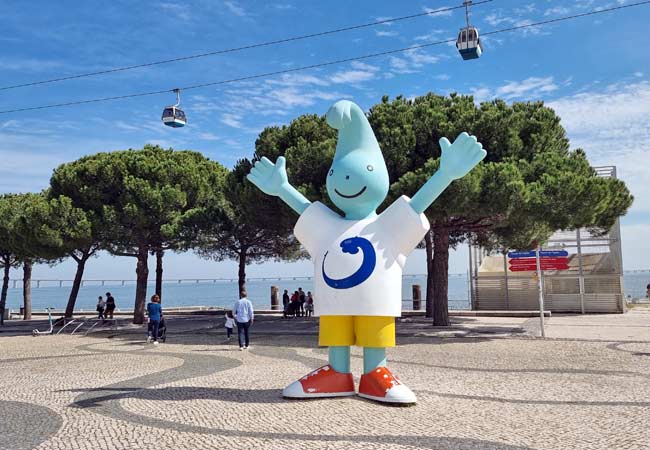
The mascot for Expo 98 was Gil
Where to eat in Parque das Nações
There is no shortage of places to eat in Parque das Nações, with over 120 eating venues ranging from fast-food venues in the shopping centre to the 'Fifty Seconds' restaurant with its €250 tasting menu.
Recommended restaurants include:
• D'Bacalhau – One of the best restaurants in Parque das Nações, serving traditional Portuguese dishes based around Bacalhau. restaurantebacalhau.com
• Honest Greens – Serving delicious, modern vegetarian food, this is always a popular spot and surprisingly not too expensive for the quality. honestgreens.com
• Senhor Peixe – An excellent seafood restaurant originally based in Setúbal, the home of Portuguese fishing. If you want a fresh fish meal, this is the restaurant to visit - senhorpeixe.pt
• The Old House – Arguably one of Lisbon's finest Chinese restaurants. - www.theoldhouseportugal.pt
• Han Table Barbecue – Enjoy the fun of Korean barbecue, where you grill your own meats and vegetables. It's a novel experience to try..
• SushiNow – Offering an outstanding 'eat as much as you can' menu of sushi and Japanese dishes, it's always popular with locals. - sushinow.com.pt
• L'Origine – Artisanal pizzas and high-quality Italian dishes. www.lorigine.pt
• Honorato – Specialising in burgers. www.honorato.pt
Note: This is only a small selection of the many restaurants in the area. When choosing a restaurant, always follow the idea that “if it's busy, it must be good.”
Parque das Nações Nightlife
The nightlife of Parque das Nações has matured over the last few years. Gone are the karaoke bars and late-night clubs, replaced by classy restaurants and stylish bars.
Parque das Nações is a great location for an evening meal and a relaxed night, but it is not the destination for late-night revelries.
One of the night-time highlights is the Casino de Lisboa, with its four floors of gambling and over 1,000 slot machines and high-end tables on the top floor.
For shisha bars and a chilled-out vibe, head to the south of Parque das Nações and visit the bars overlooking the marina. Or for high-end rooftop bars, visit 'Babylon 360' at the top of the Torre Vasco da Gama or the 'Skybar' at the top of the Tivoli Hotel.
For something at a lower price point, there is the lively 100 Montaditos, with its inexpensive drinks and filling Mexican cuisine. The Irish-themed bar ‘Irish and Co’ is another firm favourite with visitors.
Our opinion: Parque das Nações is perfect for dining and relaxed socialising. If you want to experience Lisbon's vibrant nightlife, head to the Cais do Sorde or Bairro Alto districts.
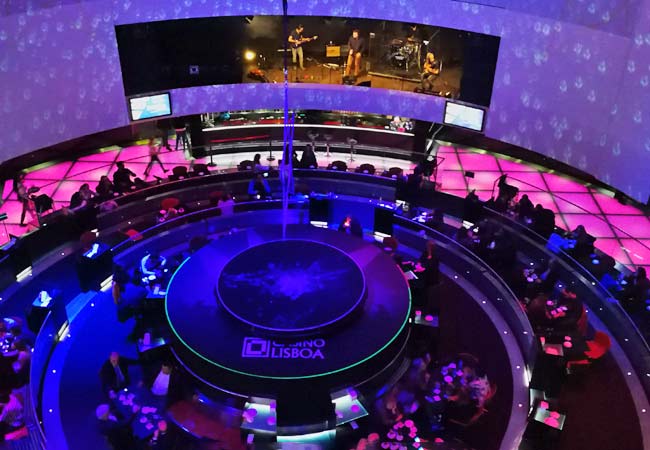
The music bar inside the Casino de Lisboa
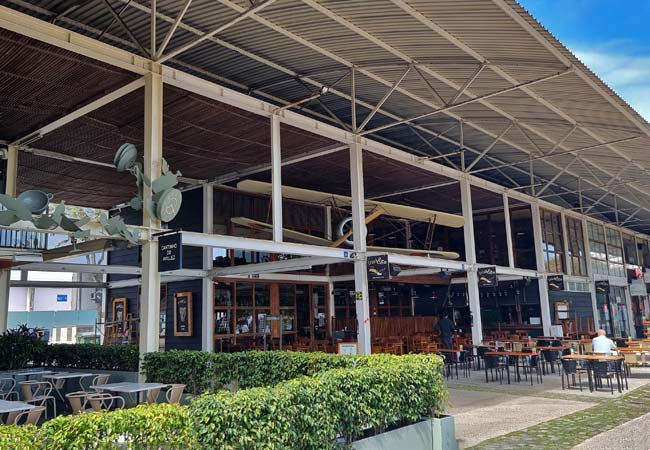
Irish and Co bar
Water everywhere…
While wandering around the Parque das Nações, it will quickly become apparent that water has a connection to many of the original exhibits and buildings constructed for Expo 98. This is because the theme for Expo 98 was ‘the world's oceans’, with the event coinciding with the 500-year anniversary of Vasco da Gama's sea voyage to India. This is also why many things in or near the Parque das Nações are named Vasco da Gama.
Some of the ocean-themed and Vasco da Gama connections are very apparent, while some are much more subtle and include:
• The Oceanário de Lisboa (an oceanarium, not an aquarium).
• The Torre de Vasco da Gama is the tallest building in Lisbon and is styled like a ship's mast and crow's nest.
• The two apartment blocks above the shopping centre represent Vasco da Gama's caravel sailing ships. The towers are also named the Torre São Gabriel and Torre São Rafael after the name of his two boats.
• The Jardins da Água (water gardens) with their refreshing waterfall and fountains.
• The Centro Vasco da Gama shopping centre, which was designed to represent a cruise ship.
• The Ponte de Vasco da Gama bridge, which - when constructed - was Europe's longest bridge over water.
• The exploding water volcano towers (no idea of the connection to the oceans, but entertaining).
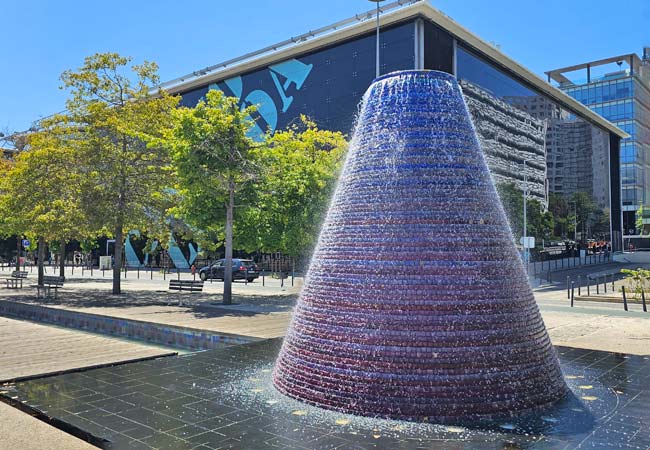
The water volcanos, great for a hot summer’s day!
A holiday based in the Parque das Nações
The Parque das Nações is not a common location for a holiday to Lisbon and is more often associated with business travellers. It may not be common, but that does not mean it is not a good area of the city to be based.
There are very good public transport connections around the city (red metro line and bus 728 to Belem and Baixa), and it is very close to the airport. Contained within the Parque das Nacoes are many modern hotels that cater to high-end/ business clientele and events. Due to the large number of hotel rooms, this is the area to look for promotions outside of the peak season.
Major sights of the Parque das Nações
Oceanário de Lisboa
The Oceanário de Lisboa is one of the finest tourist attractions of Lisbon. The complex comprises of a massive central tank and four outer tanks that represent the four different oceanic ecosystems. The range of species is outstanding and includes playful sea otters, menacing sharks, giant tuna and characterful penguins.
The oceanarium is cleverly designed so that each of the tanks can be viewed from both above and below the water level, showing completely different aspects of the environments. On the initial level you can watch the penguins waddling around the top, but later you can see them gracefully diving to the bottom of the tanks.
The Oceanário de Lisboa is an expensive tourist attraction, with an adult ticket costing €24 and a child (3 to 12) at €15.50, but it is worthy of the high entrance fee, and a typical visit will last for 2 hours.
As one of the most popular sights of Lisbon, it can get very busy at the weekends and during school holidays. It is always best to visit early or later in the day and avoid the weekends.
www.oceanario.pt/
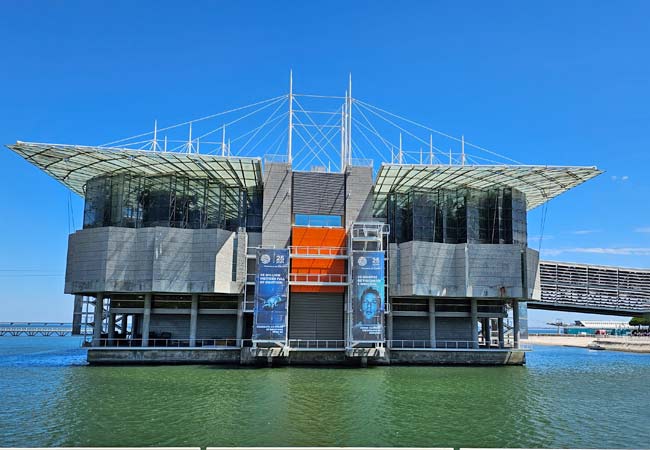
The Oceanário de Lisboa stands at the centre of its own lake
The Pavilhão do Conhecimento
The Pavilhão do Conhecimento is an outstanding science museum, which focuses more on interactive displays than wordy descriptions. The museum is designed for children, but parents will not be bored as the exhibits are creative and engaging. The entrance fee is €14/€8/€9 (adult/child/youth) and is again worth the admission fee.

The Telecabine de Lisboa
The cable car extends the length of the park, from the marina in the south to the Torre de Vasco da Gama in the north. The cars fly silently over the estuary during the 8-minute ride, and the vantage point provides wonderful panoramic views over the park.
The tickets are a little bit pricey for the activity, with a return costing €9.50 for an adult or €6.50 for a child.
www.telecabinelisboa.pt

The Torre Vasco da Gama
The Torre Vasco da Gama is Lisbon's tallest building, standing at 145 metres, and was the tallest building in Portugal when it opened in 1998. Its height is deceptive, as it stands on the banks of the Tejo estuary and does not appear so high until you are close to it.
The tower was constructed to represent a ship's mast with a crow's nest and flagpole, and it was only later in 2007 that the Myriad Hotel was constructed. At the top of the Torre Vasco da Gama is the Fifty Seconds restaurant and the Babylon 360 bar. Fifty Seconds is a Michelin-star restaurant run by renowned Spanish chef Martín Berasategui: www.fiftyseconds
It is possible to ride to the top of the tower and visit the Babylon 360 bar for €10 (before 5pm).
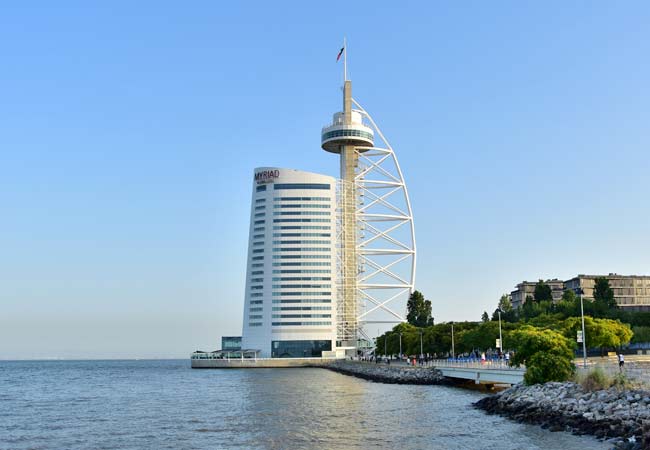
The Torre da Vasco da Gama, Lisbon's tallest building
The Vasco da Gama Bridge
The Vasco da Gama Bridge was constructed to relieve the traffic from the Ponte de 24 Abril suspension bridge and opened to coincide with Expo 98. The bridge has a total length of 17 kilometres, and at the time of opening was Europe's longest bridge. The bridge follows a simplistic design and is only constructed from concrete, but the sheer size is inspiring, especially when viewed from beneath in the Parque do Tejo.

Jardins Garcia d’Orta
The gardens of Garcia d'Orta represent five different countries discovered by Portuguese explorers: Brazil, Goa, Mozambique, Indonesia and Azores. The plants and styling of each of the gardens reflect their country of origin, and many species are non-native to Portugal.
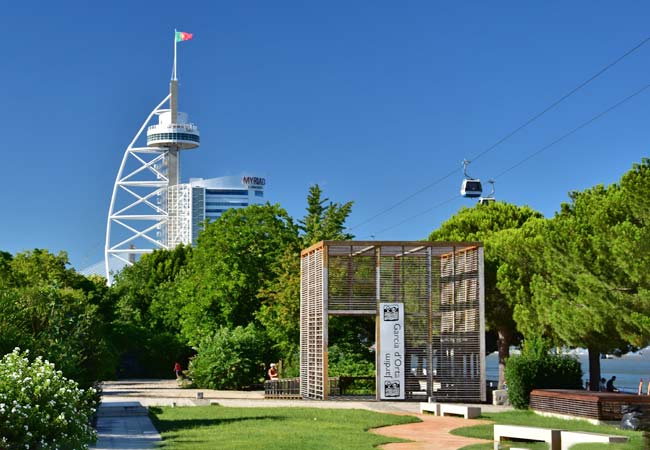
Vasco da Gama Shopping Centre
The Vasco da Gama shopping centre is one of the largest in Lisbon, with a range of multi-national, designer or branded stores based in a well-designed shopping complex. Notable things in the shopping centre include the extensive food hall on the second floor, the cinema on the top floor and the continental supermarket on the lower floor - ideal for good value foods, toiletries etc.

The Vasco da Gama shopping centre
Travel to Parque das Nações
The best way to travel to the Parque das Nações is by metro, and the district is served by the Oriente station. This station is connected to the red metro line, and a single metro ticket costs €1.85.
Oriente station is a major bus and train station that is spread over five levels and is an ultra-modern steel, concrete and glass structure. For late-night travel, there are always lots of taxis waiting at the bus station.
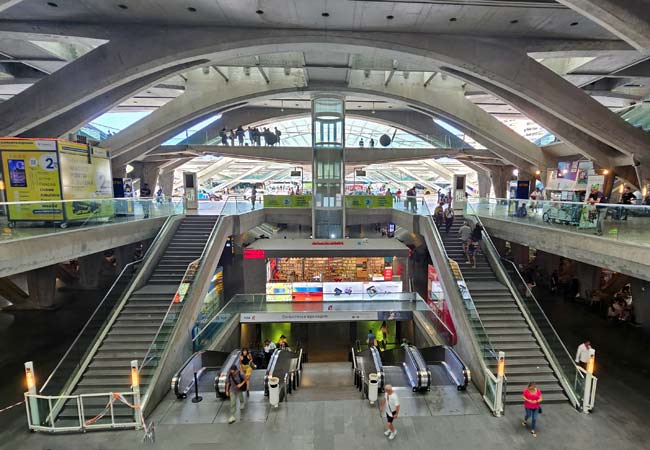
The train station at Gare do Oriente
History of the Parque das Nações and Expo Park
Parque das Nações was the site of the World Fair of 1998 and is still referred to as Expo Park - or just Expo - by many of Lisbon’s residents. Expo 98 was planned to coincide with Portugal's celebrations to mark the 500th anniversary of Vasco da Gama's arrival in India in 1498. This presented the organisers with a flexible and varied theme based around the world's oceans, entitled ‘The Oceans: A Heritage for the Future’.
Expo 98 was regarded as a great success for Portugal, and was even considered as having helped Portugal to join the European single currency.
After the ticket offices closed on Expo 98, many feared that the area would become an expensive, disused area, as with previous Expo events. The good management and foresight of the organisers ensured its transformation into a trendy and important business centre of Lisbon.
Discover more of Lisbon with our most popular guides
If you've found our content valuable, we'd welcome your support.
The digital publishing landscape has evolved significantly. As a small independent publisher, we face growing challenges. Search engines increasingly favour paid content over organic results, while AI-generated content often reproduces original work without attribution.
To support our work, please consider bookmarking this page (press Ctrl + D) for quick access. If you find an article helpful, we'd be grateful if you'd share it with friends on social media.
For specific questions, please see our Reddit community at r/LisbonPortugalTravel.
Should you notice any outdated or incorrect information, please contact us at [email protected]
Thank you for helping us continue to provide valuable content in an increasingly challenging digital environment.
A complete list of all of our Lisbon articles
If you've found our content valuable, we'd welcome your support.
The digital publishing landscape has evolved significantly. As a small independent publisher, we face growing challenges. Search engines increasingly favour paid content over organic results, while AI-generated content often reproduces original work without attribution.
To support our work, please consider bookmarking this page (press Ctrl + D) for quick access. If you find an article helpful, we'd be grateful if you'd share it with friends on social media.
For specific questions, please see our Reddit community at r/LisbonPortugalTravel.
Should you notice any outdated or incorrect information, please contact us at [email protected]
Thank you for helping us continue to provide valuable content in an increasingly challenging digital environment.



































